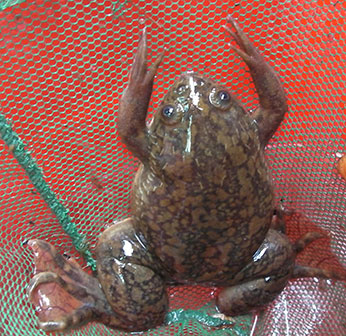(Xenopus laevis)
General Description
 Adult African clawed frog collected from the Santa Ana Watershed. Photo courtesy of Brett Mills.
Adult African clawed frog collected from the Santa Ana Watershed. Photo courtesy of Brett Mills.
 African clawed frog tadpole with distinguishing barbels.
Photo by Gary Nafis, California Herps(opens in new tab).
African clawed frog tadpole with distinguishing barbels.
Photo by Gary Nafis, California Herps(opens in new tab).
African clawed frogs are aquatic frogs with small, wedge-shaped heads and flattened bodies. They have smooth skin, often mottled, which is olive to brown in color on their backs and creamy white on their bellies. Their front feet are small and unwebbed, but their hind feet are fully webbed and armed with sharp, black claws on the three inner-most toes. The eyes of African clawed frogs are located on top of the head, turned upward, and have no lids. African clawed frogs range from 2 to over 5 inches in body length. The tadpoles are fairly transparent, tend to swim “upside down,” and can be distinguished by the presence of long, catfish-like barbels (whiskers).
Current Distribution
African clawed frogs have become established in watersheds throughout southern California in Imperial, Kern, Los Angeles, Orange, Riverside, San Bernardino, San Diego, Santa Barbara, and Ventura Counties. Additionally, an isolated population of clawed frogs is known to occur in San Francisco County in Lily Pond within Golden Gate Park. African clawed frogs have also been reported in Arizona, Colorado, Florida, Massachusetts, North Carolina, Virginia, and Wisconsin.
Habitat Preference
African clawed frogs are highly adaptable and occur in a wide variety of both natural and manmade habitats such as lakes, ponds, streams, wetlands, and canals. They prefer stagnant waters of ponds and slow streams, but are also found in fast-moving waters. Although a water-dependent species, African clawed frogs have the ability to migrate across land in search of new habitat and are capable of aestivation during dry and drought periods. African clawed frogs can tolerate variable water salinities, pH levels, temperatures, and nutrient levels, and thus are able to adapt to a variety of conditions.
Pathways
African clawed frogs are native to sub-Saharan Africa and were imported into the United States for laboratory use and the pet trade. They were originally, and continue to be, introduced into the wild by escaping from, or being released by, laboratories, research facilities, and pet owners, and disperse in the wild by swimming, moving overland, or being carried by water flows. African clawed frogs are on California’s restricted animals list and cannot be imported, transported, or possessed without a permit.
Impacts
African clawed frogs have voracious appetites and will eat anything they can catch, whether dead or alive, including aquatic invertebrates, frogs, fish, and birds, as well as their own tadpoles and recent metamorphs. As a result of these feeding behaviors, African clawed frogs prey upon and out-compete native frogs and other aquatic species. In addition, they serve as a vector for parasites and diseases that can be transmitted to native frogs. African clawed frogs are a known carrier of chytrid fungus, which causes the potentially fatal skin disease in frogs called chytridiomycosis. Chytridomycosis is believed to be a leading cause of the decline of native amphibian populations all over the world and responsible for the extinction of over 100 species since the 1970s. African clawed frogs also secrete skin toxins that may be harmful to predators, including native fish and other aquatic species.
Actions Taken if Found
If you observe this species in California, please report your sighting to the CDFW Invasive Species Program, by email to Invasives@wildlife.ca.gov, or by calling (866) 440-9530.